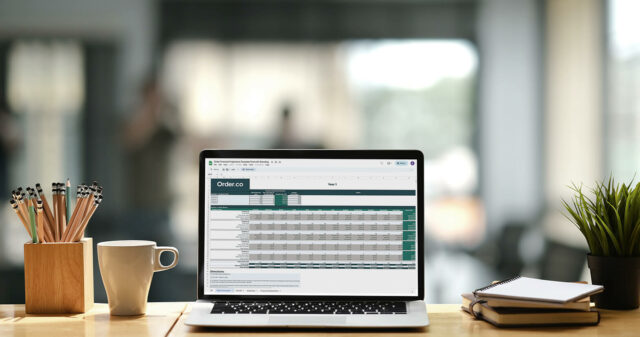The Importance of Financial Forecasting and How to Start

The Importance of Financial Forecasting and How to Start
One common pitfall for growing businesses is a lack of focus on financials. Marketing strategies and product development are undoubtedly exciting. Still, more often than not, it’s the diligent work of finance and accounting teams that keeps the business on track and moving full steam ahead.
If you’ve gotten by so far without financial forecasting, you may ask, “What’s the worst that can happen?”
The answer is “a lot” — and potentially at the worst moment. Absent or incomplete financial statements and forecasting can cause cash flow disruptions, inventory shortfalls, slow disaster recovery, reduced valuations, and problems obtaining credit.
Solid forecasting doesn’t have to be elaborate, but it should be consistent, comprehensive, and data-driven. Today, we’re covering some basics of financial forecasting and budgeting and sharing ways to improve your financial reporting.
With the right approach, you can move toward stronger financial positions and smoother operations through the inevitable peaks and valleys of running a business.
By the end of this article, you’ll know:
- What financial forecasting is and how it works
- The benefits of strong, consistent forecasting and budgeting
- How technology can boost financial forecasting.
First, let’s define forecasting and budgeting a little better.
Download the free tool: Financial Projections Template
What is financial forecasting?
Financial forecasting is the process of using past financial data and current market trends to make educated assumptions for future periods. It is an important part of the business planning process and helps inform decision-making.
Effective forecasting relies on pairing quantitative insight with creative evaluation. Taking what you know and what you believe could happen near term, you can plan for what comes next.
Forecasting factors in expected events such as predictable economic changes or business expansions. It also attempts to establish contingency plans for unforeseen events such as stock market corrections, natural disasters, or long- or short-term business disruptions.
While forecasting cannot predict or avoid every pitfall — for instance, a global pandemic — it can ease the impact of outlier events and create opportunities for growth during advantageous periods.
Forecasting vs. budgeting
There are different financial forecasting models, each with distinct features and potential benefits. (It’s important to note that what many people call forecasting is actually budgeting.)
Every business is unique and will benefit from different types of forecasting models. In general, businesses operate using either:
- A traditional, static budget that forecasts expected revenue and expenses in a single time period — typically 12 months. In this approach, the projected revenue and expenses are amended over the current period, but the time horizon remains fixed. Amendments during the forecast period happen in smaller increments as your approach period end. This forecasting process is sometimes called forecasting “to the wall.”
- Rolling forecasts take a dynamic approach to financial planning. Instead of making budget allocations and setting goals once per year, forecasting is conducted over shorter periods (often quarterly) and reviewed during each period for potential adjustments. Planning is continually added to the end of the forecast horizon. This dynamic approach to forecasting allows companies to engage in a less-intensive yet consistent forecasting and budgeting process. It is especially helpful for handling higher-variability scenarios such as fluctuating inventory and seasonal cash flow.
Why is financial forecasting important?
Forecasting is the basis of every financial decision your company will make in a given time period. Strong financial forecasting practices tend to lead to better financial outcomes, more stable cash flow, and better access to the credit and investment that can help your business grow.
With a forecast in place, department heads can more effectively plan spending for their teams. Procurement and supply chain teams can plan capacity, manufacturing, and distribution. Sales and marketing professionals can develop metrics and reasonable sales targets based on the information analysis
Forecasting also serves as an important barometer for the overall health of your financial organization. As the fiscal year progresses, having well-documented forecasting can illustrate the effectiveness of current revenue-generating strategies, contextualize current performance, evaluate the market’s effect on your financials, and help identify and correct areas of misalignment.
Forecasting serves your business decisions by:
- Providing the basis for budgeting: As we said before, forecasting and budgeting are often used interchangeably. But in reality, they are two separate processes with different goals. Forecasting is the first step of overall financial planning. It considers known data and uses that to predict and influence future, unknown events.
- Creating necessary accountability: Having a documented plan also creates benchmarks for evaluating the progress toward your financial goals. As Peter Drucker famously pointed out, “What gets measured, gets managed." Successful spend management is one of the most important ways to ensure stable financial performance over time.
- Informing strategic decisions: With access to data and a well-reasoned future plan, stakeholders can make better decisions about the strategies and investments they make. Forecasting is the way to ensure that decisions are made based on accurate historical data and properly modeled future potential.
- Improving risk evaluations: Part of financial forecasting includes finding ways to mitigate unforeseen circumstances and create contingency plans for outlier scenarios. While you can never fully mitigate risk, imaginative scenario-building can reduce liability and improve recovery from unforeseen financial events.
- Facilitating planned, consistent growth: Successful growth shouldn’t be left to chance. Forecasting models grounded in solid data and assumptions can offer insights to create cost-cutting and growth opportunities. This can help you optimize spending, so more of your dollars go into revenue-generating activities.
Basic elements of financial reporting
The basis of your financial forecasting and reporting efforts will come from the three financial statements: the Balance Sheet, the Income statement, and the Cash Flow statement. These pro forma documents interconnect to reveal a holistic view of your company’s financial life.
- Income statement: Shows business performance across periods. The Income statement reflects vital signs like revenue, cost of goods sold (COGS), gross profit, expenses, pre-tax earnings, and net earnings.
- Balance Sheet: This is a report of the assets, liabilities, and equity over the preceding forecasting period. It is a point-in-time financial snapshot of the company.
- Cash Flow Statement: This shows the cash movements in your business. The purpose of this statement is to show the net change (increase or decrease) in cash balance over each period.
Five areas to review in financial modeling
When constructing any type of financial forecast, there are certain factors you’ll want to include in your reporting. Some, like past financial data, are concrete and easily contextualized. Others rely on advanced expertise to successfully identify and model outcomes.
Five of the most important factors in a forecasting exercise are:
- Historical data: Past financial performance is the cornerstone of forecasting. Examining your financials through previous forecasting periods will surface growth opportunities. This data is your most accurate starting point for making future projections.
- Forward-looking projections: Depending on your business and reporting method, your time horizon may vary from a year to two years. These projections should attempt to predict future revenue goals, new business opportunities, and other positive impacts.
- Expense and cash flow forecasting: Your forecast should attempt to evaluate expected expenses based on current company objectives, adjusted for consequences like inflation and increased goods and services costs. The better your procurement data, the more accurately you can forecast these expenses.
- Best/worst-case scenario planning: Financial modeling is not just about statistical analysis, but creative thinking. Therefore, thorough forecasting should explore different scenarios and outlier events. This includes adverse events — such as fires, location closures, cyber attacks, and natural disasters — and positive events such as higher-than-expected revenue, investment returns, etc.
- Risk analysis: Part of your contingency planning should consider liability caused by internal and external forces. While contingency planning for outside risk sources is essential, it’s also necessary to plan for internal risk factors such as employee malfeasance, lawsuits, and crisis events.
How technology improves financial forecasting and budgeting
Understanding the impact your variable costs have on expected revenue is the best step in creating more accurate forecasts for your company.
The right software can make forecasting easier by helping you visualize expenses over time. This makes it easy to see where you’re spending your money, in order to predict future spending and unforeseen circumstances.
- Procurement often represents the lion’s share of company expenses. Using an automated procurement tool can help organizations to find cost-savings opportunities within their current purchasing process. By centralizing your data and viewing results in real-time, you will gain granular spend visibility and context for expenses. This level of detail makes projecting future expenses easier.
- These technology tools also help users streamline vendor and supply choices to reduce spending. Using curation in your purchasing saves money in the short term while stabilizing monthly invoices and creating a more consistent view of expenditures.
- Processing invoices and payments can be time-consuming. By using a tool with Integrated payments systems, stakeholders can get what they need, and accounting can buy and pay for it faster. Using a procurement software tool, users can automate invoicing to avoid penalties and realize early payment discounts. Improving your budget efficiency leaves more room in the budget for revenue-generating activities and strategies.
Using a procurement tool like Order.co, you can harness the power of data you already produce every day. Doing so can significantly improve the accuracy and effectiveness of your financial forecasting.
If your organization is ready to improve financial forecasting through better procurement management practices, schedule a demo of Order.co.
Get started
Schedule a demo to see how Order.co can simplify buying for your business.
"*" indicates required fields



